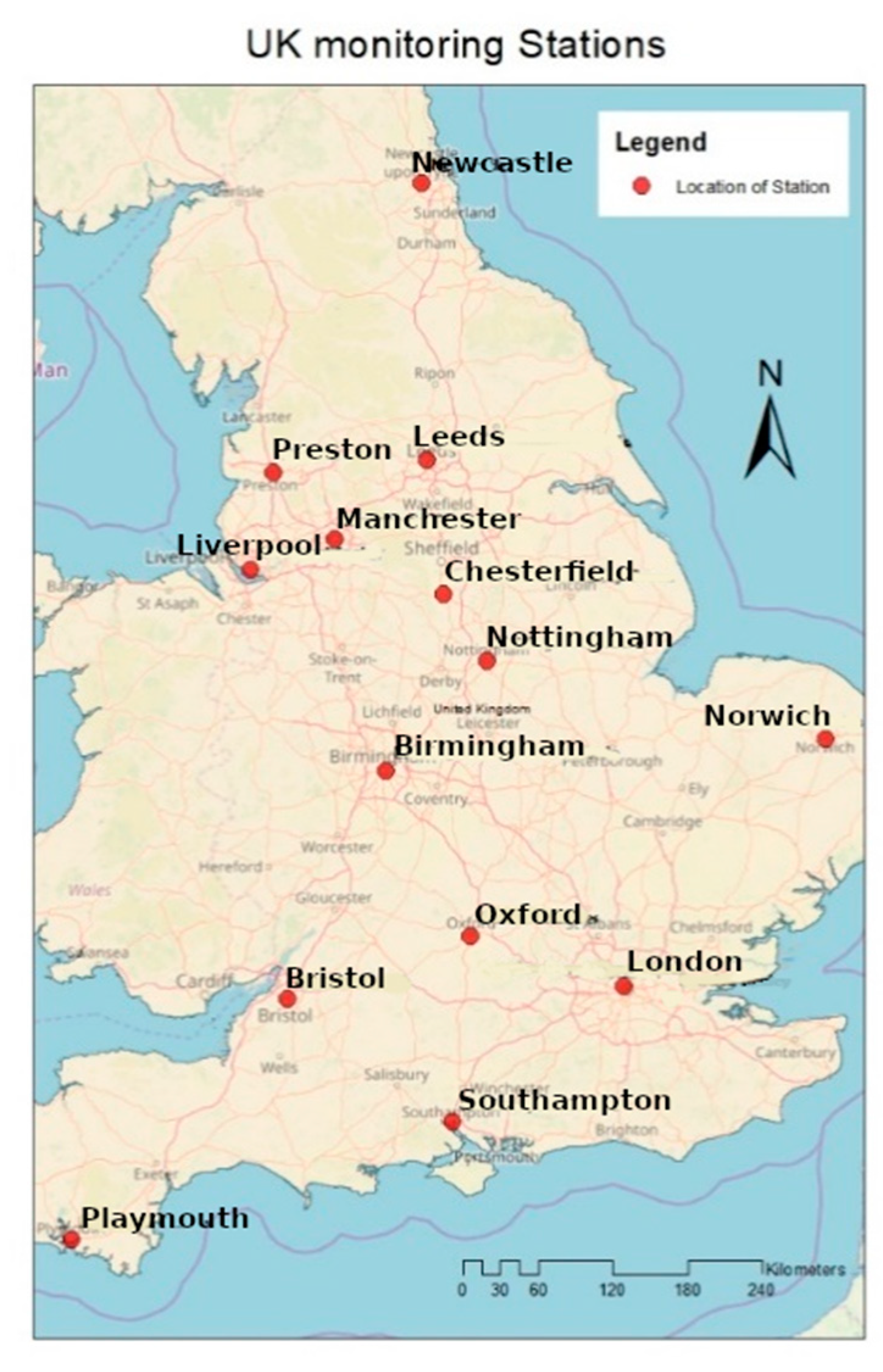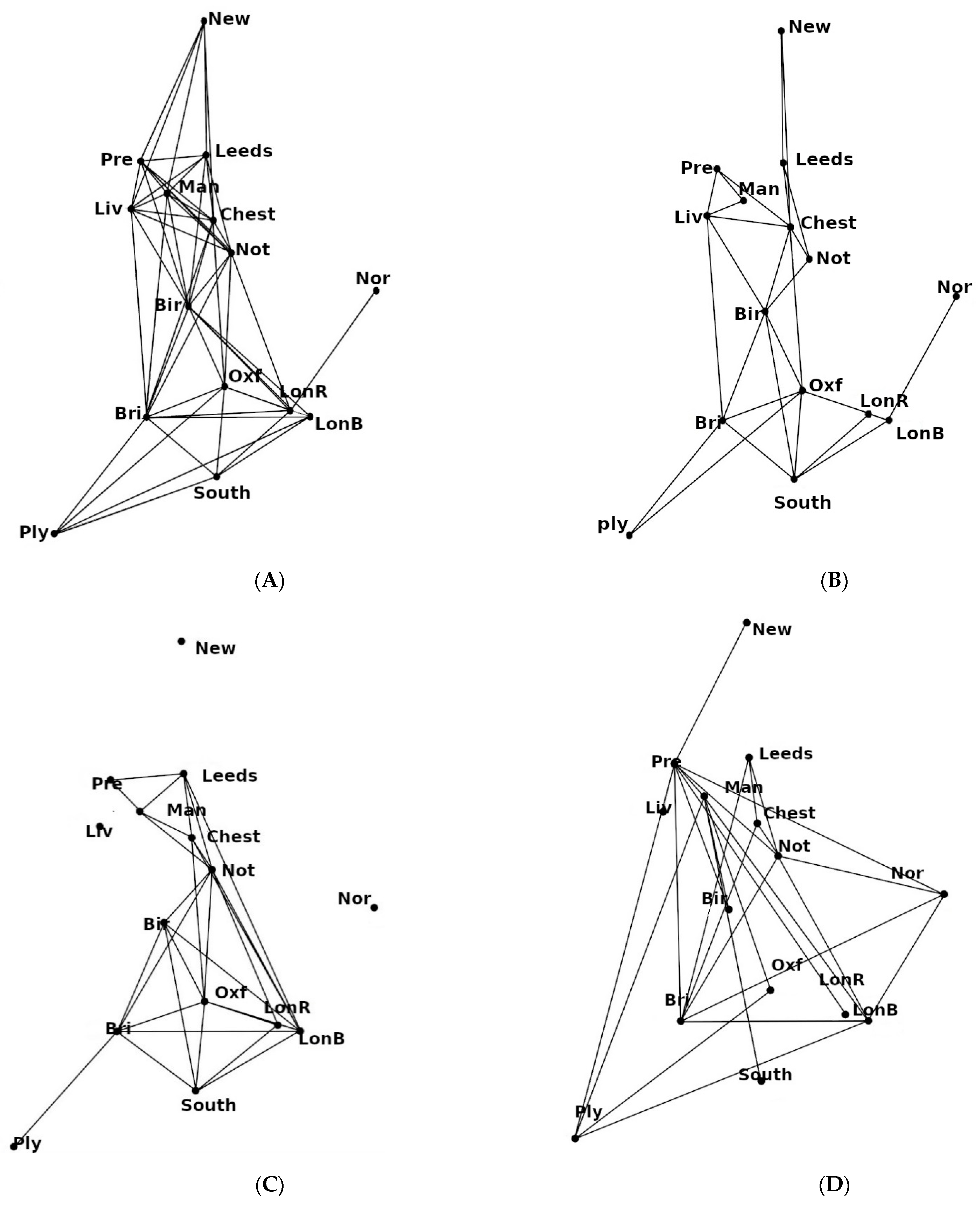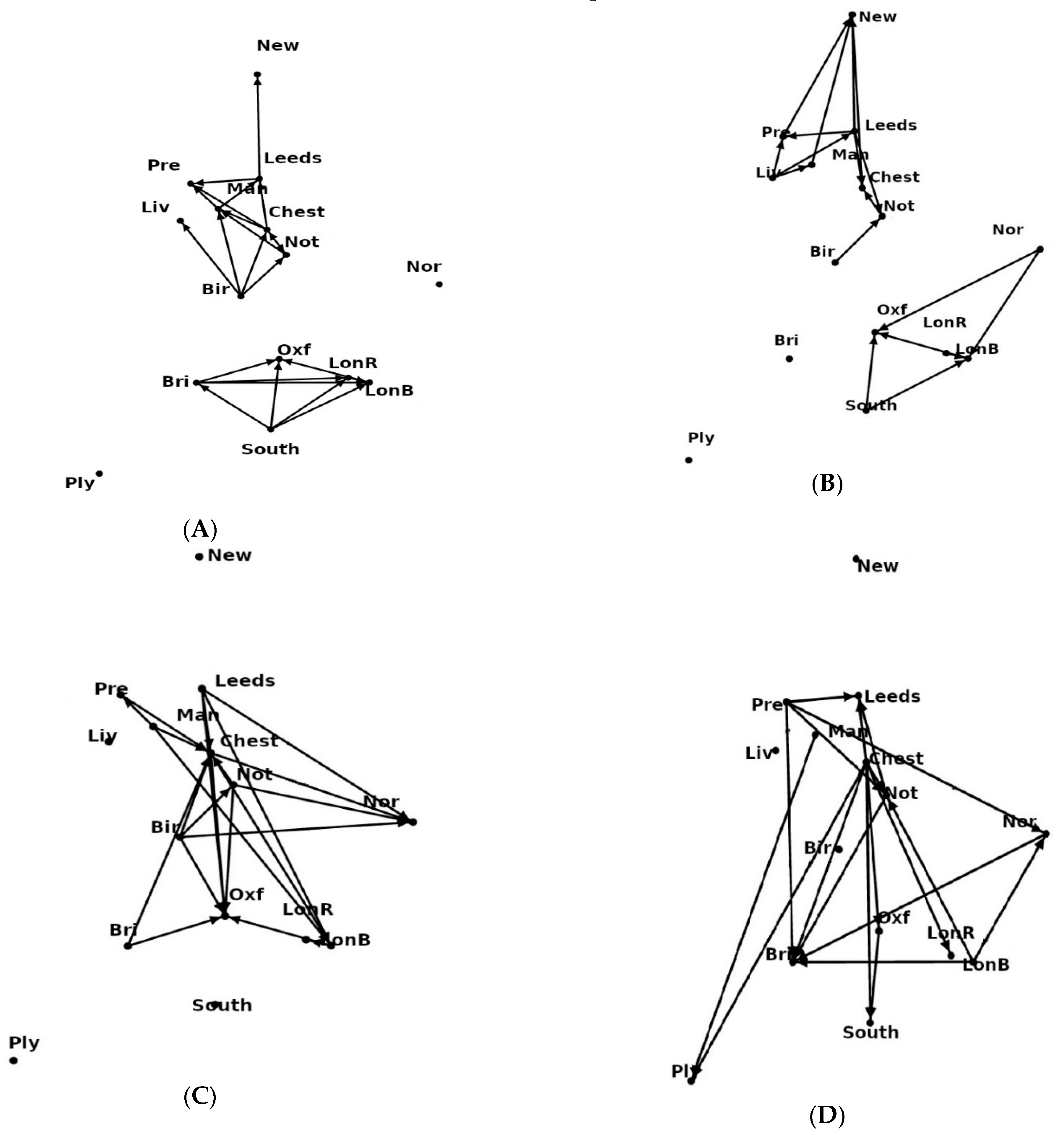Dynamic Complex Network Analysis of PM2.5 Concentrations in the UK, Using Hierarchical Directed Graphs (V1.0.0)
Abstract
:1. Introduction
1.1. Background and Rationale
1.2. Importance and Impact
1.3. Modeling Challenges
2. Materials and Methods
2.1. Ground-Level PM2.5 Data
2.2. Calculation of Cross-Correlation for Spatial Distribution of Ambient PM2.5 in the United Kingdom
2.3. Calculating Granger Causality in Ambient PM2.5 Network in the United Kingdom
2.4. Trophic Coherence
3. Results
3.1. Spatial Distribution of PM2.5 across the United Kingdom
3.2. Granger Causality Test
4. Discussion
The Impact of Meteorological Parameters on Network Structure
5. Conclusions
Supplementary Materials
Author Contributions
Funding
Institutional Review Board Statement
Informed Consent Statement
Data Availability Statement
Conflicts of Interest
References
- AQEG: Mitigation of United Kingdom PM2.5 Concentrations, Air Quality Expert Group, UK Department for Environment, Food and Rural Affairs, London, UK. PB13837. Available online: http://ukair.defra.gov.uk/assets/documents/reports/cat11/1508060903_DEF-PB14161_Mitigation_of_UK_PM2.5.pdf (accessed on 1 November 2015).
- Munir, S. Analysing temporal trends in the ratios of PM2.5/PM10 in the UK. Aerosol Air Qual. Res. 2016, 17, 34–48. [Google Scholar] [CrossRef]
- Vieno, M.; Heal, M.; Williams, M.; Carnell, E.; Nemitz, E.; Stedman, J.; Reis, S. The sensitivities of emissions reductions for the mitigation of UK PM2.5. Atmos. Chem. Phys. 2016, 16, 265–276. [Google Scholar] [CrossRef] [Green Version]
- Donkelaar, A.; Martin, R.; Brauer, M.; Kahn, R.; Levy, R.; Verduzco, C.; Villeneuve, P. Global Estimates of Ambient Fine Particulate Matter Concentrations from Satellite-Based Aerosol Optical Depth: Development and Application. Environ. Health Perspect. 2010, 118, 847–855. [Google Scholar] [CrossRef] [PubMed] [Green Version]
- Meerschman, E.; Cockx, L.; Islam, M.M.; Meeuws, F.; Van Meirvenne, M. Geostatistical Assessment of the Impact of World War I on the Spatial Occurrence of Soil Heavy Metals. AMBIO 2011, 40, 417–424. [Google Scholar] [CrossRef] [PubMed] [Green Version]
- Zhang, Y.H.; Hu, M.; Zhong, L.J.; Wiedensohler, A.; Liu, S.C.; Andreae, M.; Wang, W.; Fan, S. Regional integrated experiments on air quality over Pearl River Delta 2004 (PRIDE-PRD2004): Overview. Atmos. Environ. 2008, 42, 6157–6173. [Google Scholar] [CrossRef]
- Sandu, A.; Sander, R. Technical Note: Simulating chemical systems in Fortran90 and Matlab with the Kinetic PreProcessor KPP-2.1. Atmos. Chem. Phys. 2006, 5. [Google Scholar] [CrossRef] [Green Version]
- Eastham, S.; Long, M.; Keller, C.; Lundgren, E.; Yantosca, R.; Zhuang, J.; Li, C.; Lee, C.; Yannetti, M.; Auer, B.; et al. GEOS-Chem High Performance (GCHP v11-02c): A next-generation implementation of the GEOS-Chem chemical transport model for massively parallel applications. Geosci. Model. Dev. 2018, 11, 2941–2953. [Google Scholar] [CrossRef] [Green Version]
- Hu, L.; Keller, C.; Long, M.; Sherwen, T.; Auer, B.; Da Silva, A.; Nielsen, J.; Pawson, S.; Thompson, M.; Trayanov, A. Global simulation of tropospheric chemistry at 12.5 km resolution: Performance and evaluation of the GEOS-Chem chemical module (v10-1) within the NASA GEOS Earth system model (GEOS-5 ESM). Geosci. Model. Dev. 2018, 11, 4603–4620. [Google Scholar] [CrossRef] [Green Version]
- Nielsen, J.E.; Pawson, S.; Molod, A.; Auer, B.; da Silva, A.M.; Douglass, A.R.; Duncan, B.; Liang, Q.; Manyin, M.; Oman, L.D. Chemical Mechanisms and Their Applications in the Goddard Earth Observing System (GEOS) Earth System Model. J. Adv. Model. Earth Syst. 2017, 9, 3019–3044. [Google Scholar] [CrossRef] [Green Version]
- Cariolle, D.; Moinat, P.; Teyssèdre, H.; Giraud, L.; Josse, B.; Lefèvre, F. ASIS v1.0: An adaptive solver for the simulation of atmospheric chemistry. Geosci. Model. Dev. 2017, 10, 1467–1485. [Google Scholar] [CrossRef] [Green Version]
- Turányi, T. Parameterization of reaction mechanisms using orthonormal polynomials. Comput. Chem. 1994, 18, 45–54. [Google Scholar] [CrossRef]
- Whitehouse, L.E.; Tomlin, A.S.; Pilling, M.J. Systematic reduction of complex tropospheric chemical mechanisms, Part II: Lumping using a time-scale based approach. Atmos. Chem. Phys. 2004, 4, 2057–2081. [Google Scholar] [CrossRef] [Green Version]
- Young, T.R.; Boris, J.P. A numerical technique for solving stiff ordinary differential equations associated with the chemical kinetics of reactive-flow problems. J. Phys. Chem. 1997, 81, 2424–2427. [Google Scholar] [CrossRef]
- Kelp, M.; Tessum, C.; Marshall, J. Orders-of-magnitude speedup in atmospheric chemistry modeling through neural network-based emulation. arXiv 2018, arXiv:1808.03874. [Google Scholar]
- Porumbel, I.; Petcu, A.C.; Florean, F.G.; Hritcu, C.E. Artificial neural networks for modeling of chemical source terms in CFD simulations of turbulent reactive flows. In Modeling and Optimization of the Aerospace, Robotics, Mechatronics, Machines-Tools, Mechanical Engineering and Human Motricity Fields; Applied Mechanics and Materials; Trans Tech Publications: Stafa-Zurich, Switzerland, 2014; Volume 555, pp. 395–400. [Google Scholar]
- Mallet, V.; Stoltz, G.; Mauricette, B. Ozone ensemble forecast with machine learning algorithms. J. Geophys. Res. 2009, 114. [Google Scholar] [CrossRef] [Green Version]
- Nicely, J.; Salawitch, R.; Canty, T.; Anderson, D.; Arnold, S.; Chipperfield, M.; Emmons, L.; Flemming, J.; Huijnen, V.; Kinnison, D.; et al. Quantifying the Causes of Differences in Tropospheric OH within Global Models. J. Geophys. Res. Atmos. 2017, 122. [Google Scholar] [CrossRef]
- Nowack, P.; Braesicke, P.; Haigh, J.; Abraham, N.; Pyle, J.; Voulgarakis, A. Using machine learning to build temperature-based ozone parameterizations for climate sensitivity simulations. Environ. Res. Lett. 2018, 13. [Google Scholar] [CrossRef]
- Keller, C.; Evans, M. Application of random forest regression to the calculation of gas-phase chemistry within the GEOS-Chem chemistry model v10. Geosci. Model. Dev. 2019, 12, 1209–1225. [Google Scholar] [CrossRef] [Green Version]
- Kamali, N.; Zare Shahne, M.; Arhami, M. Implementing Spectral Decomposition of Time Series Data in Artificial Neural Networks to Predict Air Pollutant Concentrations. Environ. Eng. Sci. 2015, 32, 379–388. [Google Scholar] [CrossRef]
- Memarianfard, M.; Hatami, A.M. Artificial neural network forecast application for fine particulate matter concentration using meteorological data. Glob. J. Environ. Sci. Manag. 2017, 3, 333–340. [Google Scholar] [CrossRef]
- Shamsoddini, A.; Aboodi, M.; Karami, J. Tehran air pollutants prediction based on Random Forest feature selection method. ISPRS Int. Arch. Photogramm. Remote Sens. Spat. Inf. Sci. 2017, 483–488. [Google Scholar] [CrossRef] [Green Version]
- Zuo, X.; Guo, H.; Shi, S.; Zhang, X. Comparison of Six Machine Learning Methods for Estimating PM2.5 Concentration Using the Himawari-8 Aerosol Optical Depth. J. Indian Soc. Remote Sens. 2018, 48, 1277–1287. [Google Scholar] [CrossRef]
- Karimian, H.; Li, Q.; Wu, C.; Qi, Y.; Mo, Y.; Chen, G.; Sachdeva, S.; Zhang, X. Evaluation of Different Machine Learning Approaches in Forecasting PM2.5 Mass Concentrations. Aerosol Air Qual. Res. 2019, 19, 1400–1410. [Google Scholar] [CrossRef] [Green Version]
- Shafiee, M.; Feghhi, S.A.H.; Rahighi, J. Experimental performance evaluation of ILSF BPM data acquisition system. Measurement 2017, 100, 205–212. [Google Scholar] [CrossRef]
- Chang, S.; Chang, C.L.; Li, L.T.; Liao, S. Reinforcement Learning for Improving the Accuracy of PM2.5 Pollution Forecast Under the Neural Network Framework. IEEE Access 2019, 1, 9864–9874. [Google Scholar] [CrossRef]
- Zhao, R.; Gu, X.; Xue, B.; Zhang, J.; Ren, W. Short period PM2.5 prediction based on multivariate linear regression model. PLoS ONE 2018, 13, e0201011. [Google Scholar] [CrossRef]
- Festy, B. Review of Evidence on Health Aspects of Air Pollution—REVIHAAP Project; Technical Report; World Health Organization Regional Office for Europe: Copenhagen, Denmark, 2013. [Google Scholar]
- WHO. Air quality guidelines, global update 2005. In Particulate Matter, Ozone, Nitrogen Dioxide and Sulfur Dioxide; World Health Organization Regional Office for Europe: Copenhagen, Denmark, 2006; Available online: http://www.euro.who.int/_data/assets/pdf_file/0005/78638/E90038.pdf (accessed on 1 January 2015).
- IPCC. Climate Change 2013: The Physical Science Basis. Contribution of Working Group I to the Fifth Assessment Report of the Intergovernmental Panel on Climate Change; Stocker, T.F., Qin, D., Plattner, G.-K., Tignor, M., Allen, S.K., Boschung, J., Nauels, A., Xia, Y., Bex, V., Midgley, P.M., Eds.; Cambridge University Press: Cambridge, UK; New York, NY, USA; 1535p.
- Lim, S.; Vos, T.; Flaxman, A.; Danaei, G.; Shibuya, K.; Adair-Rohani, H.; Al-Mazroa, M.; Amann, M.; Anderson, H.; Andrews, K.; et al. A comparative risk assessment of burden of disease and injury attributable to 67 risk factors and risk factor clusters in 21 regions, 1990–2010: A systematic analysis for the Global Burden of Disease Study 2010. Lancet 2012, 380, 2224–2260. [Google Scholar] [CrossRef] [Green Version]
- EEA. Air Quality in Europe—2014 Report; EEA Report No. 5/2014; European Environment Agency, Publications Office of the European Union: Copenhagen, Denmark, 2014; Available online: http://www.eea.europa.eu/publications/air-quality-in-europe-2014 (accessed on 1 January 2014).
- Gehrig, R.; Buchmann, B. Characterising seasonal variations and spatial distribution of ambient PM10 and PM2.5 concentrations based on long-term Swiss monitoring data. Atmos. Environ. 2003, 37, 2571–2580. [Google Scholar] [CrossRef]
- COMEAP. The Mortality Effects of Long-Term Exposure to Particulate Air Pollution in the United Kingdom; Department of Health Committee on the Medical Effects of Air Pollution: Chilton, UK, 2010; ISBN 978-0-85951-685-3. Available online: http://comeap.org.uk/documents/reports.html (accessed on 1 December 2014).
- Gowers, A.M.; Miller, B.G.; Stedman, J.R. Estimating Local Mortality Burdens Associated with Particulate Air Pollution; Public Health England: Oxfordshire, UK, 2014. [Google Scholar]
- Macintyre, H.L.; Heaviside, C.; Neal, L.S.; Agnew, P.; Thornes, J.; Vardoulakis, S. Mortality and emergency hospitalizations associated with atmospheric particulate matter episodes across the UK in spring 2014. Environ. Int. 2016, 97, 108–116. [Google Scholar] [CrossRef]
- Harrison, R.M.; Laxen, D.; Moorcroft, S.; Laxen, K. Processes affecting concentrations of fine particulate matter (PM2.5) in the UK atmosphere. Atmos. Environ. 2012, 46, 115–124. [Google Scholar] [CrossRef]
- Pope, C.A.; Dockery, D.W. Health Effects of Fine Particulate Air Pollution: Lines that Connect. J. Air Waste Manag. Assoc. 2006, 56, 709–742. [Google Scholar] [CrossRef] [PubMed]
- Defra. The Air Quality Strategy for England, Scotland, Wales and Northern Ireland; Defra: London, UK, 2007. Available online: www.defra.gov.uk/environment/quality/air/airquality/strategy/index.htm (accessed on 1 July 2007).
- Official Journal. Directive 2008/50/EC of the European Parliament and the Council of 21 May 2008 on ambient air quality and cleaner air for Europe. Official Journal of the European Union L152, 1e44. Available online: http://eur-lex.europa.eu/LexUriServ/LexUriServ.do?uri=OJ:L:2008:152:0001:0044:EN:PDF.11.6.2008 (accessed on 1 May 2008).
- DEFRA. Air Pollution in the UK 2011; Department for Environment Food and Rural: London, UK, 2012. Available online: http://uk-air.defra.gov.uk/assets/documents/annualreport/air_pollution_uk_2011_issue_2.pdf (accessed on 1 December 2014).
- Hammer, O.; Harper, D.; Ryan, P. PAST: Paleontological Statistics Software Package for Education and Data Analysis. Palaeontol. Electron. 2011, 4, 1–9. [Google Scholar]
- Shafiee, M.; Feghhi, S.A.H.; Rahighi, J. Analysis of de-noising methods to improve the precision of the ILSF BPM electronic readout system. J. Instrum. 2016, 11, 11. [Google Scholar] [CrossRef]
- Shafiee, M.; Feghhi, S.A.H.; Rahighi, J. Numerical Analysis of the Beam Position Monitor Pickup for the Iranian Light Source Facility. Nucl. Instrum. Methods Phys. Res. Sect. A Accel. Spectrom. Detect. Assoc. Equip. 2016, 847. [Google Scholar] [CrossRef]
- Shafiee, M.; Behnamian, H.; Feghhi, S.A. A study of wake potentials for the pick-ups in storage ring. J. Instrum. 2017, 12, 12006. [Google Scholar] [CrossRef]
- Software, Q.M. Eviews, Version 11; IHS Global Inc.: Irvine, CA, USA, 2019. [Google Scholar]
- Papagiannopoulou, C.; Decubber, S.; Miralles, D.G.; Demuzere, M.; Verhoest, N.E.C.; Waegeman, W. Analyzing Granger Causality in Climate Data with Time Series Classification Methods BT—Machine Learning and Knowledge Discovery in Databases; Altun, Y., Das, K., Mielikäinen, T., Malerba, D., Stefanowski, J., Read, J., Žitnik, M., Eds.; Springer: Cham, Switzerland, 2017; Volume 10536, pp. 15–26. [Google Scholar]
- Papagiannopoulou, C.; Miralles, D.; Verhoest, N.; Dorigo, W.; Waegeman, W. A non-linear Granger causality framework to investigate climate–vegetation dynamics. Geosci. Model. Dev. Discuss. 2016, 1–24. [Google Scholar] [CrossRef] [Green Version]
- Pagani, A.; Mosquera, G.; Alturki, A.; Johnson, S.; Jarvis, S.; Wilson, A.; Guo, W.; Varga, L. Resilience or robustness: Identifying topological vulnerabilities in rail networks. R. Soc. Open Sci. 2019, 6, 181301. [Google Scholar] [CrossRef] [Green Version]
- Bang-Jensen, J.; Gutin, G.Z. Digraphs: Theory, Algorithms and Applications, 2nd ed.; Springer: London, UK, 2008. [Google Scholar]
- Johnson, S.; Domínguez-García, V.; Donetti, L.; Muñoz, M. Trophic coherence determines food-web stability. Proc. Natl. Acad. Sci. USA 2014, 111. [Google Scholar] [CrossRef] [Green Version]
- Barry, R.G.; Chorley, R.J. Atmosphere, Weather and Climate, 9th ed.; Routledge: Abingdon, UK, 2010; pp. 272–274. [Google Scholar]




| Distance | Pair of Connected Cities in Network | Pair of Connected Cities in Group A | Pair of Connected Cities in Group B | Outliers (Pair of Connected Cities Out of Groups) |
|---|---|---|---|---|
| Spring | ||||
| <100 km | 18 (43%) | 12 (67%) | 6 (33%) | 0 |
| <200 km | 42 (81%) | 24 (57%) | 16 (38%) | 2 (5%) |
| >200 km | 10 (19%) | 3 (30%) | 3 (3%) | 4 (40%) |
| Summer | ||||
| <100 km | 13 (52%) | 7 (54%) | 6 (46%) | 0 |
| <200 km | 25 (90%) | 12 (48%) | 13 (52%) | 0 |
| >200 km | 3 (10%) | 2 (67%) | 1 (33%) | 0 |
| Autumn | ||||
| <100 km | 15 (54%) | 9 (60%) | 6 (40%) | 0 |
| <200 km | 28 (93%) | 9 (27%) | 13 (46%) | 9 (27%) |
| >200 km | 2 (7%) | 0 | 0 | 2 (100%) |
| Winter | ||||
| <100 km | 9 (35%) | 8 (89%) | 1 (11%) | 0 |
| <200 km | 26 (41%) | 14 (54%) | 6 (23%) | 6 (23%) |
| >200 km | 37 (59%) | 0 | 7 (19%) | 30 (81%) |
| Source | Target | Distance (km) | p-Value |
|---|---|---|---|
| Spring | |||
| Manchester | Preston | 43.66 | 5 × 10−29 |
| Bristol | Oxford | 91.78 | 9 × 10−28 |
| Summer | |||
| Liverpool | Preston | 42.62 | 7 × 10−17 |
| Leeds | Newcastle | 131 | 5 × 10−11 |
| Autumn | |||
| Manchester | Preston | 43.66 | 6 × 10−23 |
| Chesterfield | Oxford | 165.11 | 3 × 10−20 |
| Winter | |||
| Chesterfield | Nottingham | 36.17 | 1 × 10−7 |
| Chesterfield | Bristol | 213.74 | 7 × 10−6 |
| Directed Network | Incoherence Factor (q) |
|---|---|
| Spring | 0.69 |
| Summer | 0.37 |
| Autumn | 0.49 |
| Winter | 0.35 |
Publisher’s Note: MDPI stays neutral with regard to jurisdictional claims in published maps and institutional affiliations. |
© 2021 by the authors. Licensee MDPI, Basel, Switzerland. This article is an open access article distributed under the terms and conditions of the Creative Commons Attribution (CC BY) license (http://creativecommons.org/licenses/by/4.0/).
Share and Cite
Broomandi, P.; Geng, X.; Guo, W.; Pagani, A.; Topping, D.; Kim, J.R. Dynamic Complex Network Analysis of PM2.5 Concentrations in the UK, Using Hierarchical Directed Graphs (V1.0.0). Sustainability 2021, 13, 2201. https://doi.org/10.3390/su13042201
Broomandi P, Geng X, Guo W, Pagani A, Topping D, Kim JR. Dynamic Complex Network Analysis of PM2.5 Concentrations in the UK, Using Hierarchical Directed Graphs (V1.0.0). Sustainability. 2021; 13(4):2201. https://doi.org/10.3390/su13042201
Chicago/Turabian StyleBroomandi, Parya, Xueyu Geng, Weisi Guo, Alessio Pagani, David Topping, and Jong Ryeol Kim. 2021. "Dynamic Complex Network Analysis of PM2.5 Concentrations in the UK, Using Hierarchical Directed Graphs (V1.0.0)" Sustainability 13, no. 4: 2201. https://doi.org/10.3390/su13042201
APA StyleBroomandi, P., Geng, X., Guo, W., Pagani, A., Topping, D., & Kim, J. R. (2021). Dynamic Complex Network Analysis of PM2.5 Concentrations in the UK, Using Hierarchical Directed Graphs (V1.0.0). Sustainability, 13(4), 2201. https://doi.org/10.3390/su13042201






